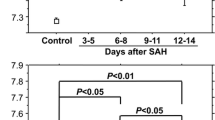Summary
Cisternal and/or ventricular cerebrospinal fluid (CSF) and arterial blood lactate and acid-base balance were measured serially in 38 patients with aneurysmal subarachnoid haemorrhage (SAH). Based on daily clinical assessment, the patients and accordingly the samples were divided into two groups according to the grading of the World Federation of Neurosurgical Societies (W.F.N.S.). In cisternal CSF, samples of Grade III–V showed significantly higher lactic acidosis than those of Grade I–II. The time course of lactate and pH in poor prognosis groups had a significant tendency of lactic acidosis, especially on the 5th, 6th, 7th day after SAH. Ventricular CSF lactate increased even without CSF acidosis in Groups III–V. Measurement of CSF lactate, especially from the cisterna magna is useful as an indicator of prognosis and changes of intracranial environment following SAH.
Similar content being viewed by others
References
Alexander SC, Workman RD, Lambertsen CJ (1962) Hyperthermia, lactic acid infusion, and the composition of arterial blood and cerebrospinal fluid. Am J Physiol 202: 1049–1054
Araki G (1980) Diagnostic significance of cerebrospinal fluid in cerebrovascular disease. Sogo Rinshou 29: 75–80
Berg B, Gärdsell P, Skånsberg P (1980) Cerebrospinal fluid lactate in the diagnosis of meningitis. Scand J Infect Dis 14: 111–115
Briem H (1983) Comparison between cerebrospinal fluid concentration of glucose, total protein, chloride, lactate, and total amino acids for the differential diagnosis of patients with meningitis. Scand J Infect Dis 15: 277–284
Desalles AAF, Kontos HA, Becker DP, Yang MS, Ward JD, Moulton R, Gruemer HD, Lutz H, Maset AL, Jenkins L, Marmarou A, Muizelaar P (1986) Prognostic significance of ventricular CSF lactic acidosis in severe head injury. J Neurosurg 65: 615–624
Feldman RA, Yashon D, Locke GE, Hunt WE (1971) Cerebral tissue lactate in experimental oligemic shock. J Neurosurg 34: 774–778
Fishman RA (1980) Composition of cerebrospinal fluid. In: Fishman RA (ed) Cerebrospinal fluid in disease of the nervous system. W. B. Saunders, Philadelphia, pp 222–223
Froman C, Smith AC (1967) Metabolic acidosis of the cerebrospinal fluid associated with subarachnoid hemorrhage. Lancet 1: 965–967
Fujishima M, Sugi T, Morotomi Y, Omae T (1975) Effect of bilateral carotid artery ligation on brain lactate and pyruvate concentration in normotensive and spontaneously hypertensive rats. Stroke 6: 62–66
Fujishima M, Nakatomi Y, Yamaki K, Ogata J, Omae T (1977) Cerebral ischemia induced by bilateral carotid occlusion in spontaneously hypertensive rats. J Neuro Sci 33: 1–11
Fujishima M (1987) Cerebrovascular disease and brain metabolism. Neurosurgeons 6: 71–81
Goldstein GW (1979) Relation of potassium transport to oxidative metabolism in isolated brain capillaries. J Physiol 286: 185–195
Granholm L (1969) The effect of blood in the CSF on the CSF lactate, pyruvate and bicarbonate concentrations. Scand J Clin Invest 23: 361–366
Granholm L, Kågström E. Rehncrona S (1977) Changes in lactate/pyruvate ratio of CSF following subarachnoid hemorrhage. Acta Neurochir (Wien) 37: 305 (Abstract)
King LR, McLaurin RL, Knowles HC (1974) Acid-base balance and arterial and CSF lactate levels following human head injury. J Neurosurg 40: 617–625
Lane DJ, Rout MW, Williamson DH (1971) Mechanism of hyperventilation in acute cerebrovascular accidents. Br Med J 3: 9–12
MacMillan V, Siesjö BK (1971) The effect of arterial hypoxemia upon acid-base parameters in arterial blood and cisternal cerebrospinal fluid of the rat. Acta Physiol Scand 83: 454–462
MacMillan V, Siesjö BK (1972) Intracellular pH of the brain in arterial hypoxemia, evaluated with the CO2 method and from the creatine phosphokinase equilibrium. Scand J Clin Lab Invest 30: 117–125
Plum F, Posner JB (1967) Blood and cerebrospinal fluid lactate during hyperventilation. Am J Physiol 212: 864–870
Posner JB, Plum F (1967) Independence of blood and cerebrospinal fluid lactate. Arch Neurol 16: 462–496
Prockop LD (1968) Cerebrospinal fluid lactic acid. Clearance and effect on facilitated diffusion of a glucose analogue. Neurology 18: 189–196
Sambrook MA, Hutchinson EC, Aber GM (1973) Metabolic studies in subarachnoid hemorrhage and strokes. I. Serial changes in acid-base values in blood and cerebrospinal fluid. Brain 96: 171–202
Sambrook MA, Hutchinson EC, Aber GM (1973) Metabolic studies in subarachnoid hemorrhage and strokes. II. Serial changes in cerebrospinal fluid and plasma urea electrolytes and osmolality. Brain 96: 191–202
Shannon DC, Shore N, Kazemi H (1972) Acid-base balance in hemorrhagic cerebrospinal fluid. Neurology 22: 585–589
Sugi T, Fujishima M, Omae T (1975) Lactate and pyruvate concentrations, and acid-base balance of cerebrospinal fluid in experimentally induced intracerebral and subarachnoid hemorrhage in dogs. Stroke 6: 715–719
Valenca LM, Shannon DC, Kazemi H (1971) Clearance of lactate from the cerebrospinal fluid. Neurology 21: 615–620
Voldby B, Enevoldsen EM (1982) Intracranial pressure changes following aneurysm rupture. J Neurosurg 56: 197–204
Yashon D, Paulson G, Locke GE, Miller C, Hunt WE (1972) Cerebral and spinal fluid anaerobism during circulatory arrest. Neurology 22: 211–214
Zupping R, Kassik AE, Raudam E (1971) Cerebrospinal fluid metabolic acidosis and brain oxygen supply. Arch Neurol 25: 33–38
Author information
Authors and Affiliations
Rights and permissions
About this article
Cite this article
Shimoda, M., Yamada, S., Yamamoto, I. et al. Time course of csf lactate level in subarachnoid haemorrhage correlation with clinical grading and prognosis. Acta neurochir 99, 127–134 (1989). https://doi.org/10.1007/BF01402321
Issue Date:
DOI: https://doi.org/10.1007/BF01402321




